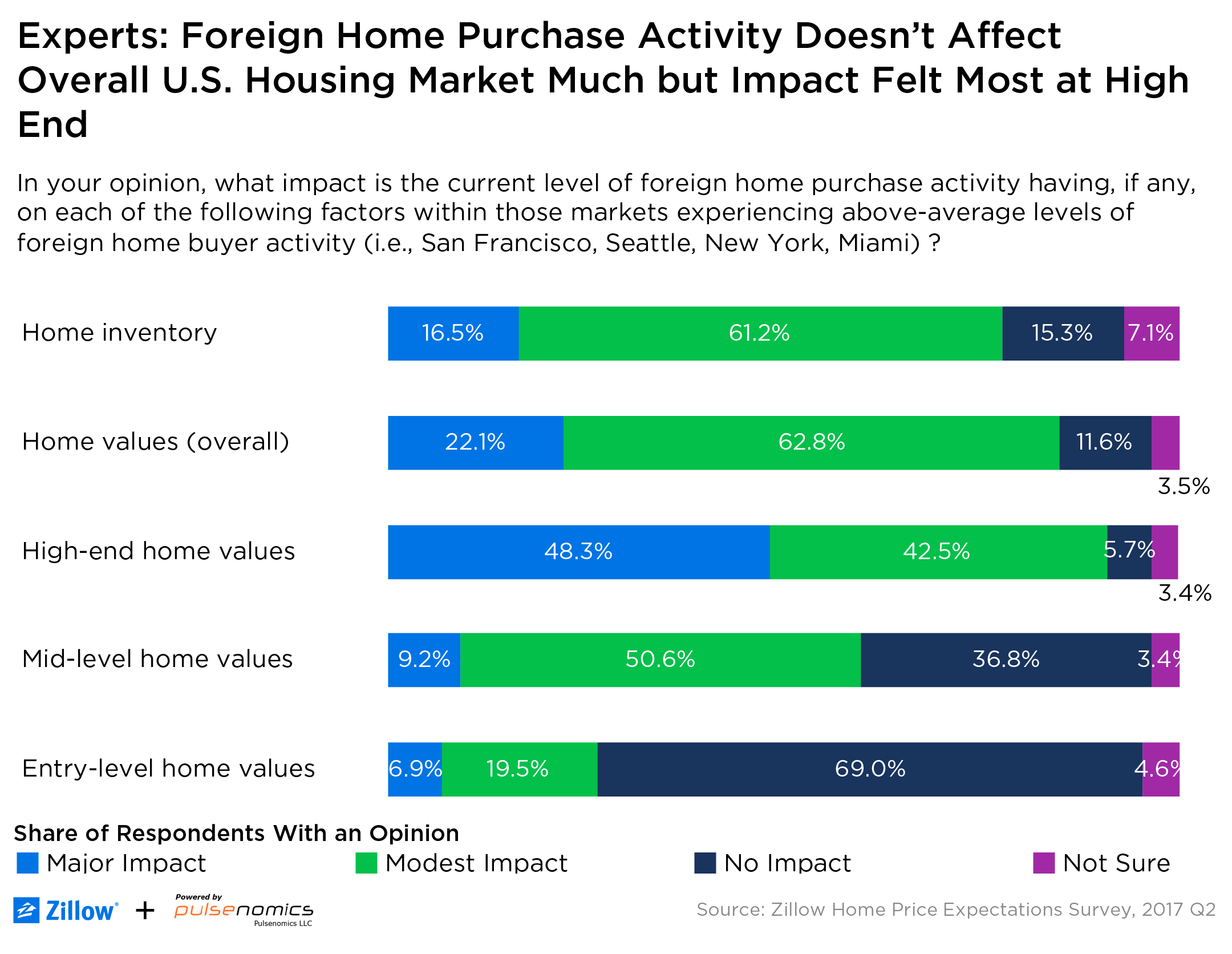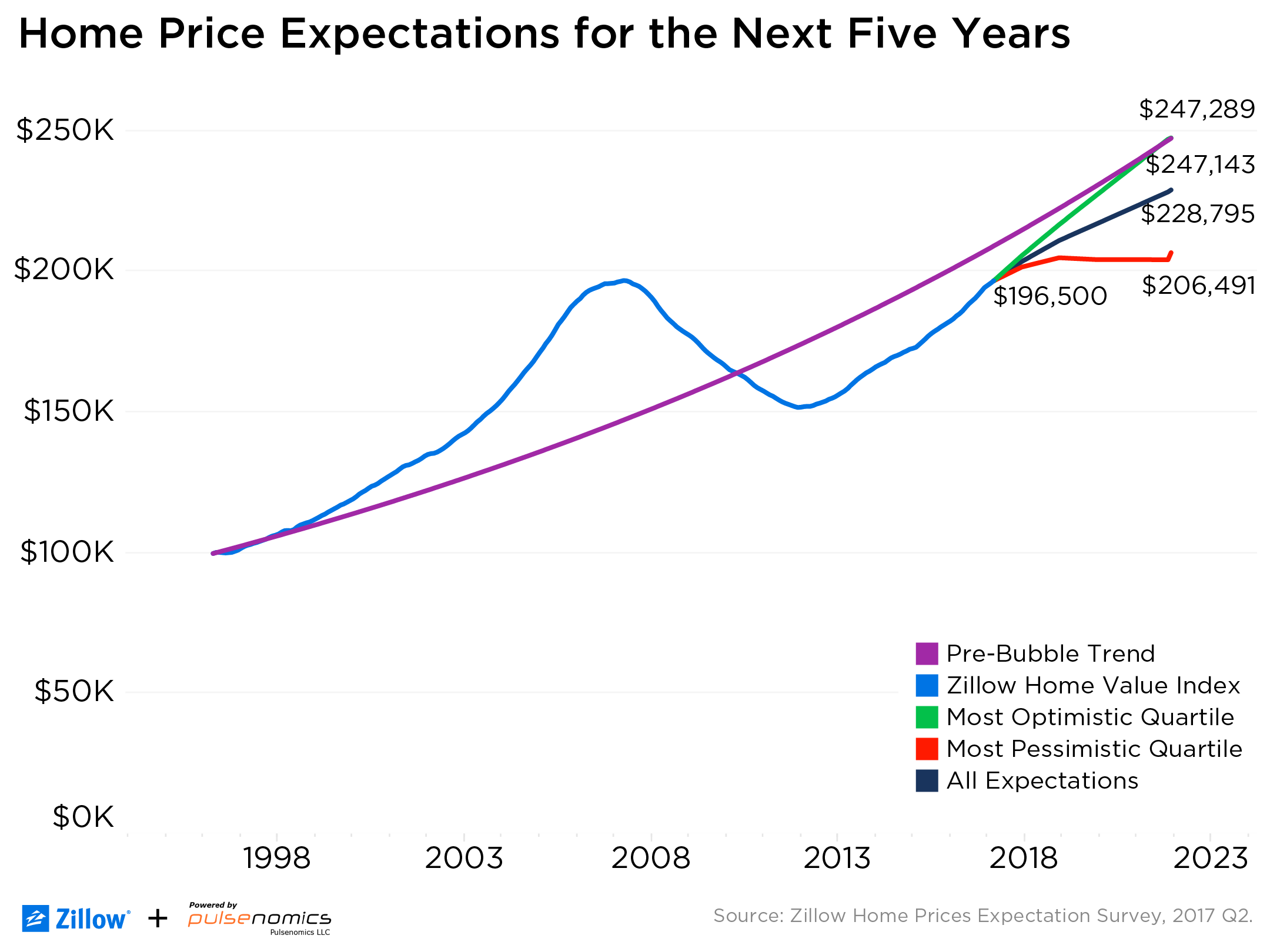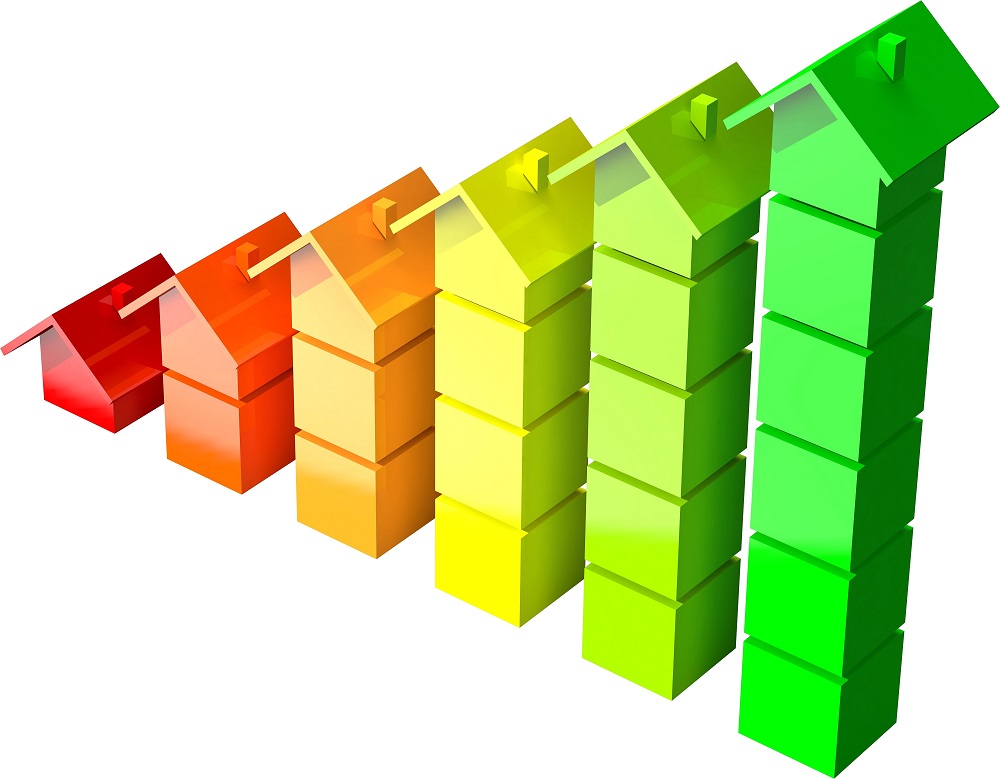Experts: Foreign Buyers to Have Limited Impact, Mostly on High-End Housing
U.S. home values are growing quickly, and expectations for future growth have also picked up. But while some may blame strong demand from overseas shoppers for rapid growth and fierce competition, experts say the impact of foreign demand on the market overall is muted at best.
- A panel of more than 100 real estate economists and experts surveyed by Zillow said demand from foreign buyers was likely to fall or stay the same this year relative to past years, and that impacts were most likely to be felt at the high end of the market.
- On average, panelists said they expected U.S. median home values to grow 4.8 percent this year and 3.65 percent in 2018.
- As low inventory and high demand have persisted over the past year-plus, panelists expectations for future home value growth have gone up.
U.S. home values are growing quickly, and expectations for future growth have also picked up. But while some may blame strong demand from overseas shoppers for rapid growth and fierce competition, experts say the impact of foreign demand on the market overall is muted at best.
 Most experts said that over the coming year, foreign investment in U.S. homes is likely to decrease or stay about the same, and that the impact of current foreign buyer activity is largely limited to the higher end of the market, according to the Q2 2017 Zillow Home Price Expectations Survey (ZHPE). The quarterly survey, sponsored by Zillow and conducted by Pulsenomics LLC, asked more than 100 housing experts and economists about the impact of international buyers on the U.S. real estate market and their expectations for home value growth over the next five years.
Most experts said that over the coming year, foreign investment in U.S. homes is likely to decrease or stay about the same, and that the impact of current foreign buyer activity is largely limited to the higher end of the market, according to the Q2 2017 Zillow Home Price Expectations Survey (ZHPE). The quarterly survey, sponsored by Zillow and conducted by Pulsenomics LLC, asked more than 100 housing experts and economists about the impact of international buyers on the U.S. real estate market and their expectations for home value growth over the next five years.
A majority of panelists with an opinion (71 percent) also said that policy responses aimed at limiting or restricting foreign home purchases would be unlikely to have much of an impact on housing affordability/home prices, or were outright counterproductive. In an effort to cool rampant home value growth and ease competition for domestic buyers, a number of cities worldwide – including Vancouver, Paris and Sydney – have introduced such policies, with mixed results.
 U.S. real estate has almost always been an attractive investment to certain foreign buyers, for a number of reasons. Panelists were asked which current factors were most likely to drive foreign home purchases this year. Among the most popular responses were: Relative stability in the U.S. in the face of financial/geopolitical uncertainty in buyers’ home markets; low interest rates and high returns on investment in U.S. real estate; policies that offer citizenship opportunities to certain foreign real estate investors; and access to good educational opportunities in the U.S.
U.S. real estate has almost always been an attractive investment to certain foreign buyers, for a number of reasons. Panelists were asked which current factors were most likely to drive foreign home purchases this year. Among the most popular responses were: Relative stability in the U.S. in the face of financial/geopolitical uncertainty in buyers’ home markets; low interest rates and high returns on investment in U.S. real estate; policies that offer citizenship opportunities to certain foreign real estate investors; and access to good educational opportunities in the U.S.
But just because U.S. real estate is a popular investment for many international buyers does not mean that the broad-based dynamics currently driving the broader national housing market – high demand, low supply and rapidly rising prices – are entirely to blame on demand from overseas.
 Many foreign home buyers, especially those from China, tend to focus their search on higher-priced homes than those sought by their American counterparts. As such, a majority of panelists with an opinion (76.5 percent) said current foreign home purchase activity was having only a modest impact or no impact on home inventory overall. A similar share (74.4 percent) said current foreign buyer activity was having only a modest or no impact on overall home values.
Many foreign home buyers, especially those from China, tend to focus their search on higher-priced homes than those sought by their American counterparts. As such, a majority of panelists with an opinion (76.5 percent) said current foreign home purchase activity was having only a modest impact or no impact on home inventory overall. A similar share (74.4 percent) said current foreign buyer activity was having only a modest or no impact on overall home values.
At the upper end of the market, however, panelists did note the impact of foreign demand. Exactly half of those with an opinion said current foreign buyer activity was having a major impact on high-end home values.
Home Value Growth: New Normal = Higher Expectations
When asked to forecast the path of home values over the next five years, panelists said they expected them to continue growing at a healthy pace into the next decade. Of the 106 panelists offering home value expectations, the average expectation was for home values to end 2017 up almost 4.8 percent, with appreciation expected to slow to 3.65 percent in 2018 and to 2.7 percent by 2021. Panelists expected cumulative home value growth from 2017 through 2021 to total almost 17.9 percent, on average.

But expectations were not uniform across the board, and varied widely between the most optimistic and pessimistic groups of forecasters. The most optimistic quartile of panelists said they expected home values to grow more than 5.8 percent through 2017 and by a cumulative 27.4 percent through 2021, on average. The most pessimistic said they expected growth just shy of 3.8 percent this year and scant cumulative growth of less than 6.4 percent through 2021.
Over the past year-plus, a persistent dynamic has helped drive home values higher nationwide and in many large markets: Inventory of homes for sale has been falling consistently, as demand from home buyers has steadily grown. It was reasonably expected that this dynamic would ease as builders brought more supply on line, more home sellers came out of the woodwork and/or rising mortgage interest rates and other market factors dampened home buying demand. But as yet, this shift hasn’t happened, nor does it seem likely to any time soon, resulting in a kind of new normal for the time being in the housing market.
As a result, over time, panelists expectations for home value growth have increased as home value growth has accelerated. A year ago, in the second quarter of 2016, panelists said they expected 2017 annual home value growth to come in at 3.4 percent, well below current expectations near 4.8 percent. Similarly, a year ago panelists expected 2018 annual home value growth slightly above 3 percent. This quarter, those expectations have been revised to annual growth of 3.65 percent.
Related:




